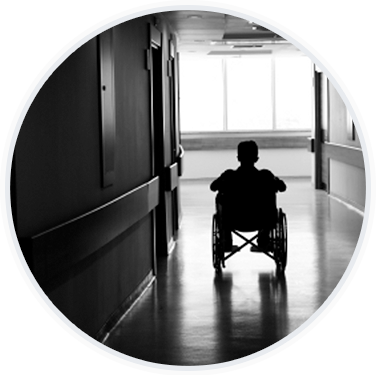Nursing Home Injuries Lawyers Wichita Kansas

Patients in nursing homes are often victims of neglect and abuse. Estimates reveal over 1.6 million people live in licensed nursing homes across the United States and another million live in other long-term care or assisted living facilities. As the baby boom generation ages the numbers will soon increase substantially. Here are just a few things that recent studies have revealed:
- 44 percent of nursing home residents have suffered some form of abuse.
- 30 percent of long-term care staff had witnessed some form of physical abuse of a patient in the previous year.
- One third of nursing homes or other long-term care facilities have been cited for violations that had the potential to lead to abuse and 10 percent were cited for actual physical abuse.
- 85 percent of nursing home staff blames staffing shortages for the cause of abuse.
Perhaps the most alarming statistic indicates that only 20 percent of nursing home neglect and abuse incidents are ever reported. There are several possible reasons. Many nursing home residents are too cognitively impaired to make a report on their own, whether they suffered the abuse or witnessed another resident being abused or those who are capable of making a report often choose not to out of fear that doing so would only cause further abuse.
In a nursing home or assisted living setting, elderly or dependent adults are neglected in various ways, including, the institutions failure to prepare and follow a care-plan (or to update the care-plan), failure to keep the resident free from safety hazards, failure to nourish with food and water, failure to provide appropriate care, and the failure to treat with dignity and/or respect.
While abuse and neglect can arise in a variety of settings and situations, the following are unfortunately recurring incidents:
- Falls Resulting in Fractures and Head Injuries– A fall inside in and of itself is not evidence of neglect, but the conduct of the facility before or after the fall can be. Was the person a fall risk? Was a care plan made to address the risk? And the care plan followed? These are but a few of the questions that need to be answered to determine whether a nursing home fall is the basis for liability.
- Wandering and Elopement – Many nursing facilities hold themselves as home for the “memory impaired,” marketing to the growing population of Americans with Alzheimer’s disease and dementia. Special care needs to be taken with this patient population, who frequently possess poor mental health. Wandering and elopement are a constant concern, and facilities are required to protect this vulnerable population from hazards, including themselves.
- Bed Sores – (a.k.a. pressure sores or decubitus ulcers) should never get so bad inside a nursing home that they are graded as a Stage III or IV. All risks for bed sores should be assessed, and a proper care plan should be enforced to address that risk. Rarely do individuals acquire Stage IV pressure ulcers absent some type of negligence.
- Malnutrition and Dehydration – Nursing homes have a duty to make sure its residents are adequately nourished. Just a few days of a failure to provide adequate nutrition can have disastrous consequences for some patients, even death. Any illness or death thought to be the result of malnutrition or dehydration should be thoroughly investigated.
- Physical and Sexual Abuse – Physical or sexual abuse by a caregiver or another resident is no longer a rare event, and should never occur, especially in care facilities that are offering professional care.
If you or a loved one have experienced negligence or abuse by a care provider, we’re here to help. Call 316-265-6000 or contact us online today!
Wichita, KS 67207
 Case Results
Case Results









